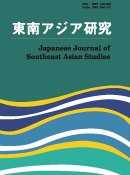巻号一覧

11 巻 (1973)
- 4 号 p. 439-
- 3 号 p. 299-
- 2 号 p. 171-
- 1 号 p. 3-
11 巻, 1 号
選択された号の論文の10件中1~10を表示しています
- |<
- <
- 1
- >
- >|
論文
-
久馬 一剛1973 年11 巻1 号 p. 3-13
発行日: 1973年
公開日: 2018/06/02
ジャーナル フリーPDF形式でダウンロード (621K) -
Ayutthaya朝よりRatanakosin朝四世王治世まで田辺 繁治原稿種別: 本文
1973 年11 巻1 号 p. 14-48
発行日: 1973年
公開日: 2018/06/02
ジャーナル フリーThe historical development of hydraulic works carried out in central Thailand seems closely determined by the physiography of the region, which is devided into the old delta, the deltaic high and the delta flat (Takaya : 1971). This article aims to analyze the regional change of the Chao Phraya delta seen as the Lebensraum (geographical living space) of the Siamese people, by investigating the formative process of the canal system before the introduction of the modern irrigation-transportation system operated by Krom Khlong (Department of Canals.)
Throughout Ayutthayan and the early Ratanakosin periods, many canals of military and transportational purposes were excavated by the Siamese kings in the delta flat region. This region, being sparesely populated, was not so important for rice cultivation untill the mid-nine-teenth century.
In the mid-nineteenth century, however, the Siamese Government, in order to meet the foreign demand for rice, tried increasing rice production by expanding rice land and, for this purpose, started the construction of a canal system for transportational and irrigational purposes on the west bank (Mahasawat, Phasicharoen, Damnoensaduak, etc.).
In spite of the efforts of the government, the reclamation of rice land did not yield the expected result as is seen in the case of the Mahasawat canal; although the large scale land-holding developed by royal families and official nobles, vast amounts of land thus occupied were left uncultivated. (to be continued)抄録全体を表示PDF形式でダウンロード (3305K)
資料・研究ノート
-
石沢 良昭1973 年11 巻1 号 p. 49-61
発行日: 1973年
公開日: 2018/06/02
ジャーナル フリーLes rois prescrivaient par leurs ordonnances de faire la part entre les biens du dieu et ceux des Pura, autrement dit entre le domaine du dieu et celui des Pura. Ces nombreuses donations ne pouvaient être acquises par les particuliers et passaient en fait dans les mains des religieux (Paṃnos); cependant, de temps en temps, les particuliers les dérobaient et s'appropriaient entre autres offrandes, les esclaves et le riz. Les fondations religieuses bénéficiaient de l'immunité fiscale en vertu des ordonnances royales et semblent avoir joui d'une certaine autonomic vis-à-vis des Pura.
Ces biens ou revenus du dieu avaient été mis en commun avec ceux d'un ou de plusierus autres sanctuaires (vieux khmer : Saṃ Paribhoga, sanscrit : micrabhoga), lesquels pouvaient d'ailleurs d'associer, mais ne partageaient pas leurs revenus avec les Pura. Par contre, le dieu est seul bénéficiaire des biens qui lui sont offerts pour son usage exclusif sans qu'il soit co-bénéficiaire avec le dieu d'un autre sanctuaire (vieux khmer : Pre Siddhi, sanscrit : Siddha). On mettait nécessairement par écrit les ordonnances royales pour assurer une garantie judiciaire dans ces deux systèmes de propriété du dieu.
C'est à I'époque du Préangkor et jusque dans les débuts angkoriens que la civilisation khmère prit sa physionomie prototypique laquelle ne subira pas de changement notables par la suite. Il serait plus difficile d'établir une nette séparation entre les époques préangkorienne et angkorienne, au point du vue des rapports concrets entre le pouvoir royal et le domaine du dieu. Disons cependant que notre étude présente essentiellement un tableau du Préangkor malgré notre documentation fragmentaire.抄録全体を表示PDF形式でダウンロード (1361K) -
金子 敬生1973 年11 巻1 号 p. 62-76
発行日: 1973年
公開日: 2018/06/02
ジャーナル フリーPDF形式でダウンロード (3063K) -
吉原 久仁夫1973 年11 巻1 号 p. 77-85
発行日: 1973年
公開日: 2018/06/02
ジャーナル フリーPDF形式でダウンロード (693K) -
医学地理学的考察堀田 進1973 年11 巻1 号 p. 86-106
発行日: 1973年
公開日: 2018/06/02
ジャーナル フリーThis article deals with data of virologic-serological surveys conducted by Kobe University and Indonesian co-operative medical teams during the period of 1964-1970. Human and animal sera collected from geographically representative areas of Indonesia were measured for hemagglutination-inhibiting (HI) antibodies against arboviruses (group A, chikungunya; group B, dengue types 1-4, yellow fever and Japanese encephalitis), influenza viruses (six A variants and one B) and rubella virus. A small-scale immunofluorescent tests of anti-EB (Epstein-Barr) antibodies were additionally carried out. Data with sera from residents of Japanese Main Islands were compared in order to look into medico-geographical features of Indonesia and Japan in the viral epidemiology. Problems of medical and public health importance, such as prediction and prevention of the possible occurrence of the diseases, significance of "Southeast Asian hemorrhagic fever, " etc., are discussed.抄録全体を表示PDF形式でダウンロード (1627K) -
シンガポールの中葯(4)新田 あや1973 年11 巻1 号 p. 107-129
発行日: 1973年
公開日: 2018/06/02
ジャーナル フリーPDF形式でダウンロード (1967K) -
フィリピンの大雨中島 暢太郎1973 年11 巻1 号 p. 130-147
発行日: 1973年
公開日: 2018/06/02
ジャーナル フリーThe mechanism of heavy rainfall in the Philippines was analyzed, taking an extraordinarily heavy rainfall of July 1972 which, for example, brought the record monthly precipitation to 4774.5mm at Baguio.
There seems to be two cases of heavy rainfall which correspond to two sets of atmospheric conditions. One is when a typhoon passes over or near the islands, and a heavy rain occurs, lasting for two to three days. The other is when a typhoon (or typhoons) comes to a halt near the islands and a monsoon current flows in from the South China Sea. In this case heavy rainfall continues for a prolonged period.
Thunderstorms are another important type of heavy rainfall for the region. The mean life time of this is shorter than 45 minutes.
In the same season, Japan also has heavy rainfalls caused by the combined effects of typhoons and Baiu-fronts. There is a close connection between the heavy rainfalls of these two regions.抄録全体を表示PDF形式でダウンロード (1338K)
報告
-
大山 良徳1973 年11 巻1 号 p. 148-163
発行日: 1973年
公開日: 2018/06/02
ジャーナル フリーPDF形式でダウンロード (2536K)
書評
-
安場 保吉1973 年11 巻1 号 p. 164-168
発行日: 1973年
公開日: 2018/06/02
ジャーナル フリーPDF形式でダウンロード (614K)
- |<
- <
- 1
- >
- >|